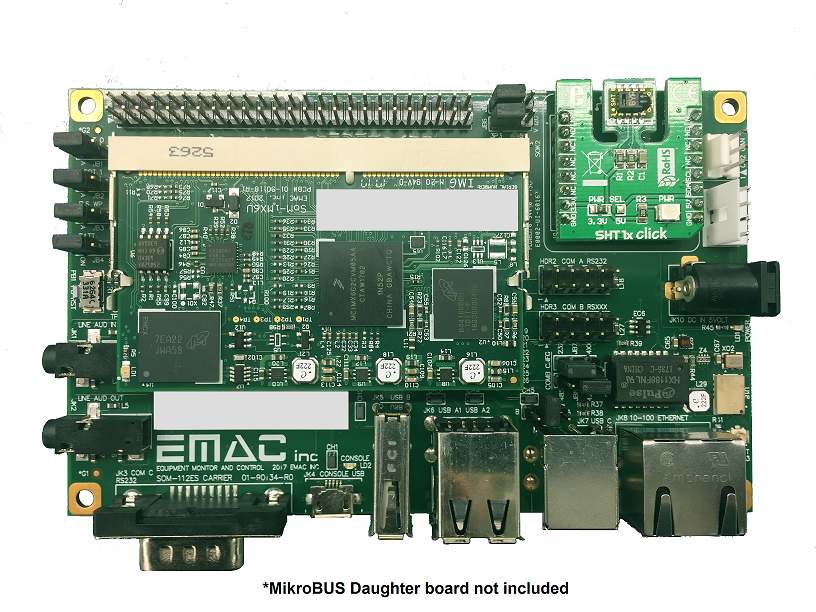EMAC has released a Request-A-Quote site with additional features and functionality.
Linux Server-In-A-Box
The most basic feature of the SIB is the stability and robustness of the software, in particular the operating system. The Linux kernel was designed with networking in mind from the start; thus all manner of network interfaces and protocols can be supported (the more common types are supported out of the box.) The Linux Operating System is also fully extensible; anything a full-sized server can do, the SIB can do, provided sufficient system resources are available. With proper configuration, the SIB can act as a file server, an NFS server, Samba (Common Internet File System for Microsoft XP file sharing,), an X-Windows application server, a network firewall, or a network router - the possibilities are nearly endless.
The EMAC Server-In-a-Box (SIB) can run Linux as its Operating System and as such retains all of the networking and communications capabilities one would expect of such an operating system. Right out of the box, the SIB is configured for Ethernet, serial IP, serial terminal, and raw serial connections. Other devices, including PPP modem links, may be added and configured by the user. EMAC's Linux Distribution can be enhanced with optional add-on modules and packages.
Configuring network devices for a minimal GNU/Linux system can be difficult. As such, EMAC has created a Dialog-based menu-driven configuration utility, which greatly simplifies configuration of SIB services, network interfaces, and communications ports. Previous experience with UNIX-like operating systems can be helpful when using the SIB, but is not necessary.
EMAC, has been manufacturing SBCs since 1985 and has been installing our own distribution of Linux in our Embedded Servers since 1998. We know Linux and we know the problems customers have in utilizing Linux. To address this, EMAC has put together a rock solid Embedded Linux distribution and a Robust Eclipse Integrated Development (IDE) package. This IDE provides GCC Cross compiler, Libraries, GDB debugger, Editor, and Project Manager all integrated into the Eclipse framework which includes sample projects. Purchase a EMAC SIB with Linux and you should be up, running and building applications the first day.
Optional Real Time
EMAC can incorporate RTAI or Xenomai Real Time extensions into it's mainstream Linux distribution to create accurate periodic user space tasks with sub-ms periods. Linux users are provided with several examples of an easy to use interface, which communicates with the boards I/O through generalized hardware classes.
STANDARD OPERATING SYSTEM FEATURES
- Based on EMAC's Linux Distribution
- HTTP Server
- SSH/SCP/SFTP Server
- FTP Server
- Dial In/Out Server and Client
- TELNET Server
- SIB Configuration Utility
- Periodic Command Scheduler (CRON)
- Access to CGI
- X-Windows on Headed versions
- FREE Eclipse IDE with GCC & GDB development tools
Optional FIREWALL (FIB) Features
(this option available for any SIB with dual Ethernet)
- Powerful firewalling and port forwarding
- Caching Name Server with DNS capability
- DHCP Server
- Support for Bandwidth allocation
STANDARD FEATURE DESCRIPTIONS
Configuration Utility
Configuring a UNIX-like operating system can be difficult when performed by simple editing of the numerous configuration files. To remedy this, the SIB includes a menu-driven, Dialog-based configuration utility, which is accessible locally via terminal or remotely via telnet. This utility allows the user to configure serial ports, SLIP ports, PPP ports, terminal ports, dial-in ports, and all manner of LAN / Internet networking options.
HTTP Server
The EMAC SIB uses an HTTP server which is quite small in terms of both disk space required and resources required while running. It is also relatively fast even under heavy load (50 hits/second), equaling or beating the industry standard Apache web server. The SIB supports standard HTML1.1 and CGI methods GET and POST. Other HTML features (client-side image maps and Java / Javascript) are implicitly supported by the server, but may or may not be supported by your browser.
FTP Server
The SIB uses a small, stand-alone FTP server which you may use to transfer files to and from the SIB. (The SIB does not have or require an FTP client.) In its default configuration, the FTP server will allow only a single user FTP access (for security reasons). More FTP users may be added later. The server may also be configured to allow anonymous FTP access to the SIB, if desired.
SSH/SCP/SFTP Server
Since FTP is not secure, the SIB provides a SSH/SCP/SFTP stand-alone server which you may use to transfer files to and from the SIB. When using the SSH/SCP/SFTP stand-alone server all data sent and received is encrypted assuring secure communication. Compared to the earlier SCP protocol, which allows only file transfers, the SFTP protocol allows for a range of operations on remote files.
Dial In/Out Server and Client
The SIB includes software and scripts which allow it to both dial out, and to answer incoming modem connections. Connections may be remote terminal sessions (similar to telnet), or PPP connections. Dial-in terminal sessions allow the user to configure and manage the SIB as if they were at the SIB's own keyboard. The PPP connection allows a user to use standard internet clients such as FTP clients and WWW browsers to access the SIB via telephone. The SIB may also dial out, either on command or as part of an automated script.
TELNET Server
The SIB includes a standard TELNET server (daemon) which will allow remote TELNET (terminal-style) access over a LAN or the Internet. Once simple network configuration has been performed, you may telnet to your SIB from any computer which has network access to the SIB. As with FTP, TELNET is not secure and SSH should be utilized.
Periodic Command Scheduler (CRON)
The SIB comes with the standard UNIX periodic command scheduler, CRON. This is a program which runs in the background, executing specified commands at specified times. Programs can be executable binaries or shell scripts. CRON is configured from the main system configuration utility.
Users
The SIB comes pre-configured with two user accounts. Each account has its own particular function:
The www user account is for configuration of the SIB. When user config logs in, instead of being presented with a standard command-line prompt, the main system configuration menu appears. The system may then be configured. When the configuser exits the main configuration menu, he is logged out and a new login: prompt appears. Thus, user config can never have access to a command line. This allows the SIB to be configured by a user who need not be given full access to the SIB, easing configuration and adding security. The www user can also be used to manage the web pages which are served by the SIB. User www has full read and write permission to all HTML and CGI files, as well as access to all configuration files and utilities. This allows www to create and delete HTML files, and FTP new HTML files and CGI programs to the SIB. This separation of privileges increases system security.
The root user account does not launch the configuration menu and has not user restrictions.
Other Features
As the SIB software was designed to take as little space as possible, other features are sparse, but useful. The available text editors are nano and vi. Standard UNIX command-line tools are also available through BusyBox, including grep and sed. The standard shell is bash. Shell scripting is fully supported. The archiving utilities tar and gzip are available, should you wish to transmit a logfile via e-mail.




